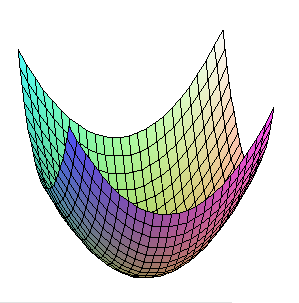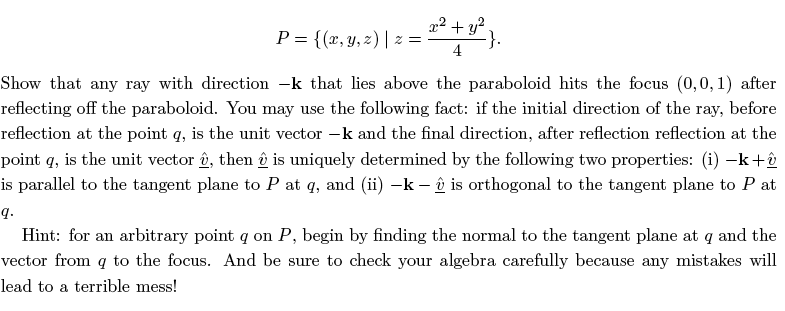

Sarahisme
Senior Members-
Posts
826 -
Joined
-
Last visited
Content Type
Profiles
Forums
Events
Everything posted by Sarahisme
-

IN DESPERATE NEED OF HELP!!! - partial derivatives!!
Sarahisme replied to Sarahisme's topic in Homework Help
well this is what i have done so far, but i don't really know what i am doing... z = f(x,y) and [math] r = \sqrt(x^2 + y^2) \implies y = \sqrt(r^2 - x^2)[/math] so z = [math] f(x, (r^2 - x^2)^{0.5})[/math] so [math] \frac{\partial z}{\partial x}|_r = \frac{\partial z}{\partial x} \frac{\partial x}{\partial x} + \frac{\partial z}{\partial y} \frac{\partial }{\partial x}(r^2 - x^2)^{0.5} [/math] [math] = \frac{\partial z}{\partial x} - \frac{\partial z}{\partial y} \frac{x}{(r^2 - x^2)^{0.5}}[/math] but yeah... now i'm stuck -
Hi all, i am having real difficulty doing this partial deriv. problem! would anyone be able to help me? (i am not even sure where to start really! ) Thanks Sarah
-

optical fibre related problem (i find it hard! :P )
Sarahisme replied to Sarahisme's topic in Homework Help
now for part ©: using the formula: [math] F =( \frac{n_1 - n_2}{n_1 + n_2} )^2 [/math] , where F is the fraction of power that is reflected back. we know [math] n_1 \ and \ n_2 [/math] from part (a) so plugging these values in we get: F = 0.0348 but only 1% of the input power makes it to the end of the fibre (that is [math] \frac{I_{out}}{I_{in}} ) [/math], so the amount of power reflected from the end of the fibre (as a fraction) is [math] F \frac{I_{out}}{I_{in}} [/math] So the amount of power reflected from the end of the fibre is: [math] F \frac{I_{out}}{I_{in}} = (0.0348)(0.01) = 0.000348 [/math] which as a percentage is 0.0348% now i just relised that there is another bit to part ©, which is that we also have to find the fraction of power that arrives back at the begining of the fibre as a percentage of the input power. so to do this: so we know only 1% of the power leaving one end of the fibre reaches the other end. so the amount of the reflected power that arrives back at the begining as a fraction of the input power is (0.01)(0.000348) = 0.00000348 = 0.000348% so how was that for part © ?? -

optical fibre related problem (i find it hard! :P )
Sarahisme replied to Sarahisme's topic in Homework Help
now for part (b): we are given that : [math] \alpha = -0.2 dB/km[/math] and since [math] \alpha = \frac{10log_{10}(\frac{I_{out}}{I_{in}})}{L} [/math] we want to find [math] \frac{I_{out}}{I_{in}} [/math] so rearranging gives: [math] log_{10}(\frac{I_{out}}{I_{in}}) = \frac{L \alpha}{10} [/math] plugging in for the RHS gives: [math] log_{10}(\frac{I_{out}}{I_{in}}) = \frac{(100km) (-0.2dB/km)}{10} = -0.2[/math] so [math] \frac{I_{out}}{I_{in}} = 0.01 [/math] and to get [math] \frac{I_{out}}{I_{in}} [/math] as a percentage, you multiply by 100 so therefore the fraction of power arriving at the end of the 100km fibre as a percentage of the power entering the fibre is 1% how was that for part (b)?? -

optical fibre related problem (i find it hard! :P )
Sarahisme replied to Sarahisme's topic in Homework Help
ok here is my working, (a) [math] L_1 = 100 \times 10^{3} m [/math] [math] \lambda_1 = 0.5 \times 10^{-6} m [/math] [math] \lambda_2 = 1 \times 10^{-6} m [/math] so [math] n(\lambda_1) = 1.459 - 0.002(0.5) = n_1[/math] and [math] n(\lambda_2) = 1.459 - 0.002(1) = n_2 [/math] now [math] n_1 = \frac{c}{v_1} \implies v_1 = \frac{c}{n_1} [/math] [math] v_1 = \frac{L_1}{t} \implies t = \frac{L_1}{v_1}[/math] likewise [math] n_2 = \frac{c}{v_2} [/math] [math] v_2 = \frac{L_2}{t} [/math] so [math] v_2 = \frac{c}{n_2} [/math] [math] L_2 = v_2t [/math] so [math] L_2 = \frac{c}{n_2} \frac{L_1}{v_1} = \frac{c}{n_2} \frac{L_1n_1}{c} = \frac{L_1n_1}{n_2} [/math] so the difference in length between the fibres is: [math] |L_1 - L_2| = 100 \times 10^{3} m - \frac{L_1n_1}{n_2} m [/math] plugging in the values gives: [math] |L_1 - L_2| = 68.63 m [/math] so how was that for part (a)? -

optical fibre related problem (i find it hard! :P )
Sarahisme replied to Sarahisme's topic in Homework Help
oh i think what i've got means that 3.48% of the 1% of the power that makes it to the end is reflected...right? part (a) is the one i am most unsure about, to do that i just used the fact that n = c/v and v = L/t -

optical fibre related problem (i find it hard! :P )
Sarahisme replied to Sarahisme's topic in Homework Help
??? -
Hey i am having a few problems with this question related to optical fibres. or at least i think i am . if i put up my answers, could someone who has a little bit of free time tell me if they are correct? Thanks Sarah Here is the question: my answers are: (a) [math] L_2 - L_1 = 68.63 m [/math] (b) 1% © [math] F =( \frac{n_1 - n_2}{n_1 + n_2} )^2 [/math] , where F is the fraction of power that is reflected back. so since [math] n_1 = 1.459 - 0.002(0.5) [/math] and [math] n_2 = air = 1 [/math] the plugging this into to F gives : [math] F = 0.0348 [/math] so therefore the fraction of power reflected from the interface as a percentage of the input power is 3.48 % how was all that?
-
right o , thanks swansont!
-
ok, cool, thanks! whats wrong with the units? their standard specific heat unit arnt they? (they use the same units for specific heat in the question)
-
hey i've got a bit of a tricky (i think it is anyway ) specific heat problem, and i just wanted to check that i'd got it right. so if anyone has a couple of mins free, could they please check my answer? Thanks -Sarah my answer is : [math]c_m = 450 \frac{J}{kg.K} [/math]
-

complex matrices and diagonalisability (is that a word?? :P)
Sarahisme replied to Sarahisme's topic in Homework Help
ok, its good, i've got it now! thanks for the help Tom -

complex matrices and diagonalisability (is that a word?? :P)
Sarahisme replied to Sarahisme's topic in Homework Help
what does this notation mean? "P=[pij[/sub]]" -

complex matrices and diagonalisability (is that a word?? :P)
Sarahisme replied to Sarahisme's topic in Homework Help
ok , yep i can do this bit, its the proof i ama having trouble with i think.... a non-diagonalisable 2x2 complex matrix is: [math]A=\left[\begin{array}{cc}0&i\\0&0\end{array}\right][/math] hows that? however i don't know where to start with the proof... :S -

complex matrices and diagonalisability (is that a word?? :P)
Sarahisme replied to Sarahisme's topic in Homework Help
anyone? -
nup its ok i know what i did wrong! i should have taken the unit vector qF!!!! woohoo i solved it! :):D:D:D:D:D:D
-
-
ahhh i don't see where i have gone wrong, i think i've made a small slip somewhere (either that or i am way off track ) anywho, heres what i did (the question is attached as a picture)... Let q = (a,b,c), so c = [math] \frac{a^2 + b^2}{4} [/math] now i get the tangent plane to P at q to be z = [math] \frac{a^2 + b^2}{4} + 0.5a(x - a) + 0.5b(y-b) [/math] and the normal at q to be n = (0.5a)i + (0.5b) -k then i call the vector qF the vector from q to the focus so i get qF to be qF = <-a,-b,1-c> then i figure all i need to do is show that (-k + qF) is parallel to the tangenet plane to P at q. That is that (-k + qF) is perpendicular to the normal vector at q. I then also need to show that (-k - qF) is orthogonal to the tangent plane. That is that (-k - qF) is parallel to the normal vector at q. To show that (-k + qF) is perpendicular to the normal vector at q i use the dot product rule so i need to show that (-k + qF).(n) = 0 likewise for (-k - qF), i need to show, using the cross product, that (-k - qF)x(n) = 0 and it almost works but i think the normal thing show have [math] \frac{1}{4} [/math]'s in it....anyway...does anyone know where i have gone wrong? or did i ever even go in the right direction to begin with? Thanks Sarah p.s. i also attached a picture of the parabaloid (in the next post) if that helps people ( i think its the right graph, i don't use maple much...) is it the right graph?
-
right ok, thanks
-
hello?
-
nevermind, i think what i've got is correct!
-
oh yeah, i just wanted to know if i had done things correctly? :S
-
[math] m = 0.1g = 0.1 \times 10^{-3} kg [/math] [math] \Delta t = 0.1 s [/math] PE of ball = [math] (0.1 \times 10^{-3} kg)(9.81 ms^{-2})(1m) [/math] but only 0.05% of it is converted into a sound wave so : Energy (E) = [math] (0.0005)(0.1 \times 10^{-3} kg)(9.81 ms^{-2})(1m) [/math] Now Power is Energy per unit time, so Power (P) is: [math] E = \frac{(0.0005)(0.1 \times 10^{-3} kg)(9.81 ms^{-2})(1m)}{0.1s} [/math] Intensity is Power per unit area (since it can be approimated to a point source of sound the area is the surface area of a sphere, [math] 4 \pi r^2 [/math], so Intensity is : [math] I = \frac{(0.0005)(0.1 \times 10^{-3} kg)(9.81 ms^{-2})(1m)}{(0.1s)(4 \pi r^2)} [/math] Since we are given that the lowest audible intensity is [math] 10^{-11} Wm^{-2} [/math] then we set I = [math] 10^{-11} Wm^{-2} [/math] so we have: [math] \frac{(0.0005)(0.1 \times 10^{-3} kg)(9.81 ms^{-2})(1m)}{(0.1s)(4 \pi r^2)} = 10^{-11} Wm^{-2} [/math] So then rearranging and solving for r gives: r = 200 m ( to 1 sig. fig.) now for part (b) we just set I = [math] 10^{-8} Wm^{-2} [/math] instead, so we have : [math] \frac{(0.0005)(0.1 \times 10^{-3} kg)(9.81 ms^{-2})(1m)}{(0.1s)(4 \pi r^2)} = 10^{-8} Wm^{-2} [/math] now rearraging for r gives : r = 6 m (to 1 sig. fig.)
-
anyone going to help me at all here?



